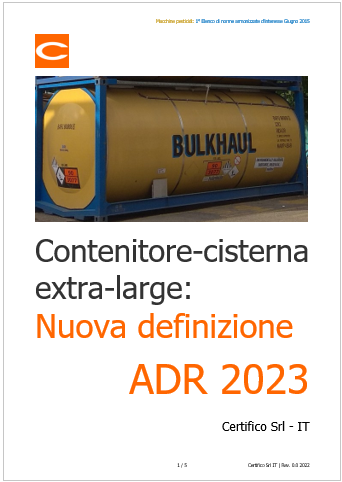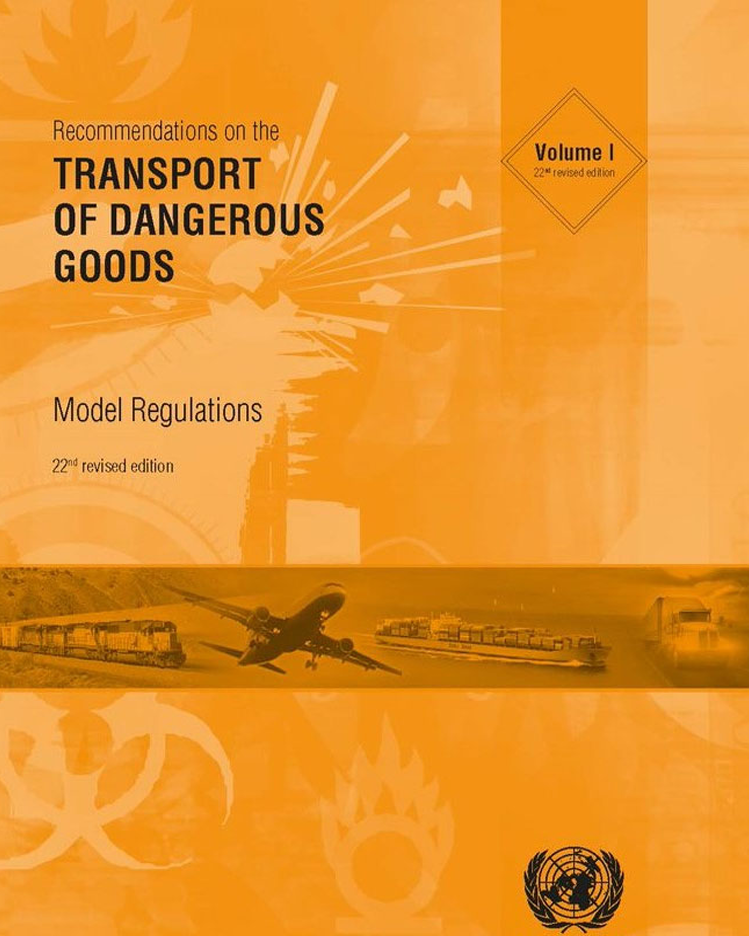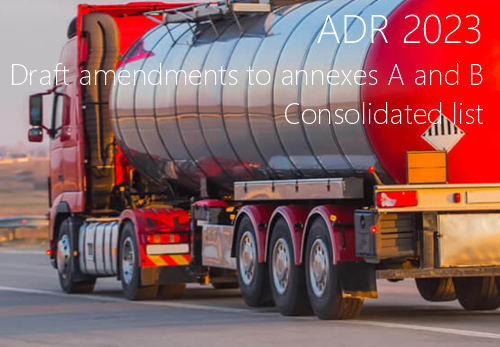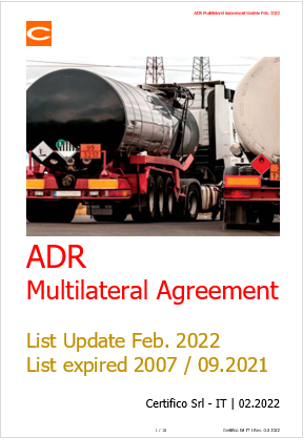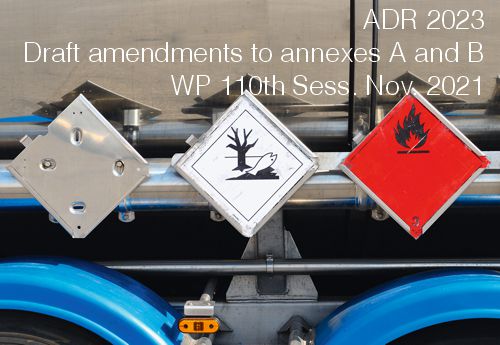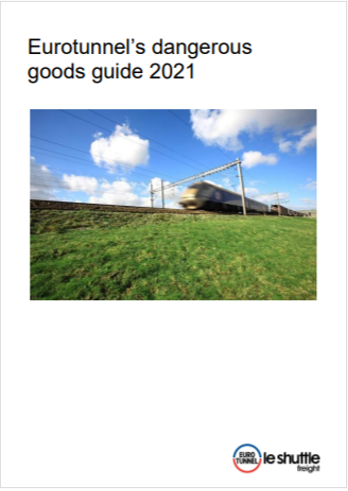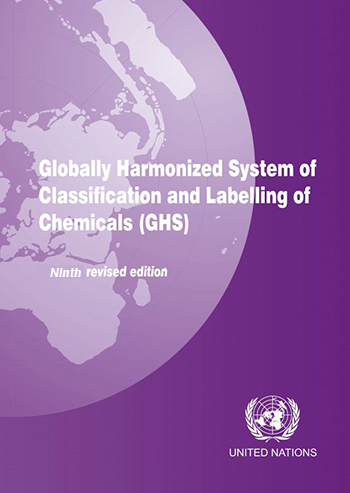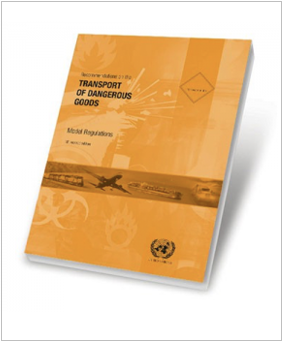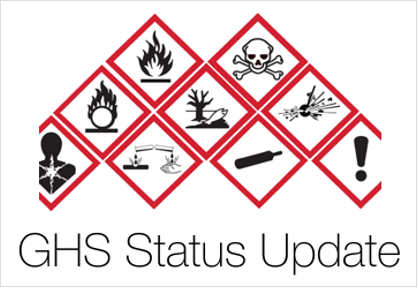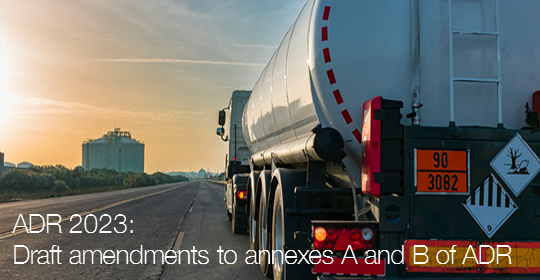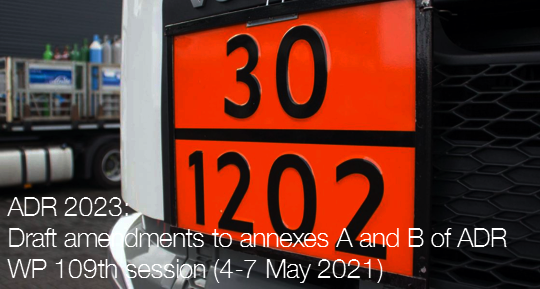Safety ADR / Dangerous Goods App
Safety ADR© è un’app per il trasporto di merci pericolose ADR che consente di:
– visualizzare tutta la Tabella A cap. 3.2 ADR per ONU/denominazione/classe/altro* (Italiano, Inglese);
– compilare per ciascuna materia ADR il “Report materia” con il parametro “Safety” (1) (Italiano, Inglese);
– compilare per ciascuna materia ADR la “Tremcards P.0” (2) (Italiano, Inglese);
– consultare le Istruzioni Scritte secondo l’ADR (Inglese, Italiano, Francese, Russo, Danese, Lettone, Norvegese, Svedese, Tedesco, Ungherese, Romeno, Portoghese, Ceco, Spagnolo, Turco, Sloveno, Slovacco, Estone, Neerlandese (Belgio), Neerlandese (Paesi Bassi), Polacco, Finlandese, Lituano, Bulgaro, Greco, Serbo);
– avere news in tempo reale visualizzate direttamente in Home;
– consultare l’accordo ADR (Inglese, Francese);
– consultare le etichette ADR, le classi, i Kemler (Italiano, Inglese).
Contenitore-cisterna extra-large / ADR 2023
Contenitore-cisterna extra-large: nuova definizione ADR 2023
ID 16970 | 29.06.2022 / Documento allegato
Con l’ADR 2023 è introdotta la definizione di Contenitore-cisterna extra-large (Extra-large tank-container). Altre info collegate alla nuova definizione in aggiornamento. Note sulla definizione di container.
ADR 2023 WASTE estimated in the transport document
ADR 2023: Waste estimated quantity in the transport document
_______
5.4.1.1.3.2 If it is not possible to measure the exact quantity of the waste at the place of loading, the quantity according to 5.4.1.1.1 (f) may be estimated for the following cases under the following conditions:
(a) For packagings, a list of packagings including the type and the nominal volume is added to the transport document;
(b) For containers, the estimation is based on their nominal volume and other available information (e.g. type of waste, average density, degree of filling);
(c) For vacuum-operated waste tanks, the estimation is justified (e.g. by means of an estimation provided by the consigner or by vehicle equipment).
Such estimation of the quantity is not allowed for:
– Exemptions for which the exact quantity is essential (e.g. 1.1.3.6);
– Waste containing substances mentioned in 2.1.3.5.3 or substances of Class 4.3;
– Tanks other than vacuum-operated waste tanks.
A statement shall be included in the transport document, as follows:
“QUANTITY ESTIMATED IN ACCORDANCE WITH 5.4.1.1.3.2”.”
UN Model Regulations 22A Revised edition (2021)
UN Model Regulations 22A Revised edition (2021)
20.03.2022 / Volume I-II-corrigendum
At its tenth session, (11 December 2020), the Committee adopted a set of amendments to the Model Regulations on the Transport of Dangerous Goods (see ST/SG/AC.10/48/Add.1), concerning, inter alia:
– Electric storage systems (including modification of the lithium battery mark and provisions for transport of assembled batteries not equipped with overcharge protection);
– Requirements for the design, construction, inspection and testing of portable tanks with shells made of fibre reinforced plastics (FRP) materials;
– Listing of dangerous goods; and
– Harmonization with the IAEA Regulations for the Safe Transport of Radioactive Material.
ADR 2023: Draft amendments to annexes A and B of ADR for entry into force on 1 January 2023
ADR 2023: Draft amendments to annexes A and B of ADR for entry into force on 1 January 2023
UNECE, 22.02.2022
ECE/TRANS/WP.15/256 – 18 February 2022
This document contains the requested consolidated list of amendments adopted by the Working Party at its 108th, 109th and 110th sessions (see ECE/TRANS/WP.15/251, annex I, ECE/TRANS/WP.15/253, annex I and ECE/TRANS/WP.15/255, annex II).
At its 110th session, the Working Party on the Transport of Dangerous Goods requested the secretariat to prepare a consolidated list of all the amendments which it had adopted for entry into force on 1 January 2023 so that they could be made the subject of an official proposal in accordance with the procedure set out in article 14 of ADR, which, following usual practice, the Chair would be responsible for transmitting to the depositary through his Government. The notification would have to be issued no later than 1 July 2022, with a reference to 1 January 2023 as the scheduled date of entry into force.
List Multilateral Agreement ADR / Update Feb. 2022
List Multilateral Agreement ADR / Update Feb. 2022
20.02.2022
– List Update Feb. 2022
– List expired 2007 / 09.2021
______
Lista degli accordi bilaterali/multilaterali in vigore (e lista scaduti) data news completi di:
– Testo accordo MA (link al MA)
– Paesi sottoscrittori alla data
– Data scadenza
– Lista MA scaduti dal 2007 al 2 Settembre 2021
Gli accordi multilaterali sono previsti dall’ADR al capitolo 1.5, sono sottoscritti tra due o più Paesi aderenti all’ADR e consentono deroghe, su norme specifiche ed hanno una data di scadenza.
Alcuni di questi Accordi Multilaterali sono stati sottoscritti anche dall’Italia e quindi sono validi anche per i trasporti sul territorio nazionale italiano.
…
ADR 2023: Draft amendments to annexes A and B | WP 110th Sess. Nov. 2021
Eurotunnels 2021 ADR Dangerous Goods Regulated
Eurotunnels 2021 ADR Dangerous Goods Regulated
I – Introduction to Eurotunnel’s dangerous goods policy
II – Definition of terms used
III – List of dangerous goods accepted
Class 1: Explosive substances and articles
Class 2: Gases: compressed, liquefied or dissolved under pressure
Class 3: Flammable liquids
Class 4.1: Flammable solids
Class 4.2: Substances liable to spontaneous combustion
Class 4.3: Substances, which in contact with water, emit flammable gases
Class 5.1: Oxidizing substances
Class 5.2: Organic peroxides Class
6.1: Toxic substances Class
6.2: Infectious substances
Class 7: Radioactive materials Class 8: Corrosive substances
Class 9: Miscellaneous dangerous substances and articles
IV – What to do on arrival at the Freight Terminal
V – Eurotunnel contact details
I – Introduction to Eurotunnel’s dangerous goods policy The Channel Tunnel has been designed to be one of the safest transport systems known to date. Eurotunnel’s dangerous goods policy is therefore intended to ensure the safety of its customers and staff, and the integrity of the Tunnel. This policy has been produced in close collaboration with industry and with relevant trade and professional bodies.
The carriage of dangerous goods through the Channel Tunnel must comply with ADR (Agreement concerning the International Carriage of Dangerous Goods by Road).
Dangerous goods definitions are subject to the current revision of the ADR regulations and Eurotunnel Freight will accept, restrict or refuse goods on the basis of these definitions. This dangerous goods policy has been decreed by a By-Law in the UK and an Arrêté Ministériel in France and forms an integral part of Eurotunnel’s Conditions of Carriage.
The carriage of dangerous goods must also comply with Eurotunnel’s own regulations as described on this website, which are more stringent than those in ADR, to reflect the specific safety characteristics of the Channel Tunnel infrastructure.
The carrier is responsible for ensuring that the goods being transported comply with these regulations. Declarations must be made using the current revision of ADR applicable at the time of travel, in one of the official languages of ADR – English, French or German. Furthermore, it is also the carrier’s responsibility to provide the compulsory documentation, including for vehicles travelling under the provisions of ADR chapter 1.1.3.6.
Dangerous goods being carried under the ADR Limited Quantity, Excepted Quantity or any other Special Provisions, which do not need documentation, do not need to be declared at Check-in. However, if these goods are declared, a full ADR declaration must be provided. Eurotunnel Freight reserves the right to authorise or refuse carriage of dangerous goods via Eurotunnel Freight, irrespective of their type, origin and / or destination. The Channel Tunnel has been designed to be one of the safest transport systems known to date.
…
add more
GHS Rev. 9 September 2021
GHS Rev. 9 September 2021 / Globally Harmonized System of Classification and Labelling of Chemicals
At its tenth session (11 December 2020), the “Committee of Experts on the Transport of Dangerous Goods and on the Globally Harmonized System of Classification and Labelling of Chemicals” adopted a set of amendments to the eighth revised edition of the GHS which include :
- the revision of chapter 2.1 (explosives) to better address their explosion hazard when they are not in their transport configuration;
- the revision of decision logics
- The revision of the classification and labelling summary tables in Annex 1;
- the revision and further rationalization of precautionary statements and
- the updating of references to OECD test guidelines for the testing of chemicals in annexes 9 and 10.
UNECE
UN Model Regulations 21A Revised edition (2019) Updaste March 2021
UN Model Regulations 21A Revised edition (2019) Update March 2021 (Corrigendum 1)
At its ninth session (7 December 2018), the Committee adopted a set of amendments to the Model Regulations on the Transport of Dangerous Goods, concerning, inter alia, electric storage systems (including lithium batteries installed in cargo transport units and defective batteries), explosives, infectious waste of Category A, waste gas cartridges, harmonization with the 2018 Edition of IAEA’s Regulations for the Safe Transport of Radioactive Material, listing of dangerous goods, update of LC50 values for some toxic gases and use of in vitro skin corrosion methods for classification.
This twenty-first revised edition of the Recommendations takes account of all the amendments which were circulated as document ST/SG/AC.10/46/Add.1.
Volume I (EN/FR) December 2018
Volume II (EN/FR) December 2018
Corrigendum 1 (EN/FR) March 2021
GHS Status Update
GHS Status Update
Document prepared by the GHS Sub-Committee secretariat Updated on 3 May 2021
Aware of the importance of monitoring the GHS status of implementation worldwide, the secretariat of the GHS Sub-Committee has collected information publicly available from various sources. These include reports from international organisations, United Nations institutes, programmes and specialized agencies, industry associations and information publicly available on the internet (press releases, articles etc).
This document (in attachment) contains information about the countries listed below (in alphabetical order) as of 03 May 2021.
[box-info]GHS Editions
The first edition of the GHS, which was intended to serve as the initial basis for the global implementation of the system, was adopted in December 2002 and published in 2003. Since then, the GHS has been updated, revised and improved every two years as needs arise and experience is gained in its implementation.
The eighth revised edition of the GHS (GHS Rev.8), published in 2019, is the most recent published revised edition. The ninth revised edition (GHS Rev.9) will be published in 2021.[/box-info]
ADR 2023: Draft amendments to annexes A and B of ADR
ADR 2023: Draft amendments to annexes A and B of ADR for entry into force on 1 January 2023 / Status
Update 01.06.2021 / UNECE WP.15
– Report of the Working Party on its 109th session (4-7 May 2021) – ECE/TRANS/WP.15/253 (Report 26 May 2021)
– Report of the Working Party on its 108th session (10-13 November 2020) – ECE/TRANS/WP.15/251 (Report 3 December 2020)




